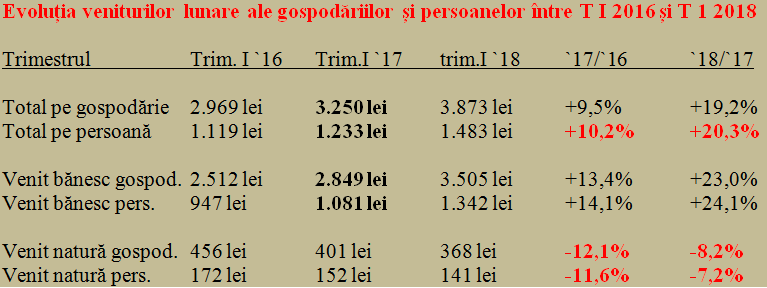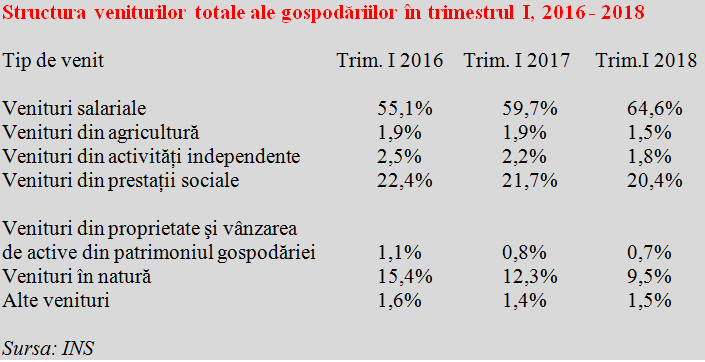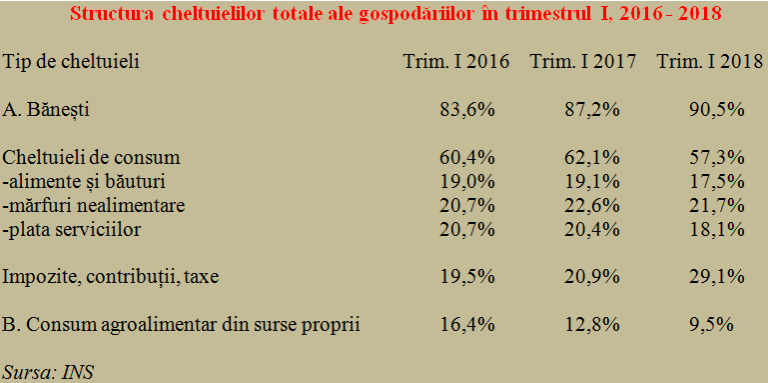 Data released by the INS for the first quarter of 2018 show that households’ living standards increased considerably compared to the same quarter of the previous year, about five times more than the GDP growth (+ 20.3% per person at a GDP growth rate of only four percentage points).
Data released by the INS for the first quarter of 2018 show that households’ living standards increased considerably compared to the same quarter of the previous year, about five times more than the GDP growth (+ 20.3% per person at a GDP growth rate of only four percentage points).
This is a significant recovery compared to the same period of the previous year when the similar score was „only” 10.2% to 5.7%
The average monthly income per household increased from 2,969 lei to 3,250 lei and the income per family member increased from 1,119 lei to 1,233 lei per person, which indicates growth rates of + 19.2% per household and +20.3% per person (following the downward trend in the number of people from a household, which reached 2.61 people versus 2.65 just two years ago) – see the table.
*
- Evolution of monthly incomes of households and persons between Q1 2016 and Q1 2018
- Quarter Q1 2016 Q1 2017 Q1 2018 ‘17/’16 ‘18/’17
- Total household
- Total per person
- Household cash income
- Cash income per person
- Income in kind per household
- Income in kind per person
*
Cash incomes recorded a significantly higher advance than in the first quarter of last year (around 70%). The increase in the cash income per person was exceptional, of +24.1%. In contrast, the substantial adjustment of in-kind income continued, even though at a slower pace (-7.2% per person versus -11.6% in the same quarter of 2017).
In this context, it is worth highlighting the increase in the share of cash incomes, for the first time, over the 90% threshold, well above the levels registered in Q1 2017 (87.7%) and Q1 2016 (84.6%), given that the share of wage income has reached the 65% threshold. Also noteworthy is the decrease in the share of income from social benefits, which three years ago was 25.2% of the total and now came to represent only 20.4%.
In-kind income declined considerably in terms of importance to an average household (probably even more in most cases), from 15.4% in Q1 2016 to only 9.5% in Q1 2018. The self-consumption phenomenon decline shows a natural evolution towards Westernization. Revenues from agricultural activities and self-employment have also declined over the last two years.
*
- Structure of total household incomes in Q1 2016-2018
- Income type Q1 2016 Q1 2017 Q1 2018
- Salary
- Revenues from agriculture
- Self-employed
- Social benefits
- Property income and income from selling household assets
- In-kind income
- Other income
*
The income growth per person in the urban area (+21.6%, from RON 1,465.50 to RON 1,781.79) was (again) significantly higher than the income increase in per person in the rural area (+ 17.6%, from RON 965.18 to RON 1.134,96 lei). Consequently, the urban/rural gap in terms of living standards has increased from about 52%, in Q1 2017 to 57% in Q2 2018.
Evolution in terms of expenditure
On the expenditure side, it would be worth mentioning the increase of almost seven percentage points in the share of cash expenditures to the detriment of agri-food consumption from own sources. An extraordinary increase was recorded in terms of taxes and contributions, from about 20% to around 30% and the explanation was the transfer of social contributions.
*
- Structure of total household expenditure in Q1, 2016-2018
- Expenditure type
- A/ Cash
- Consumption
- – food and beverages
- – non-food goods
- – services
- B/ Agri-food consumption from own sources
*
In the urban area, nearly a third of incomes went to the taxes and contributions segment (32.9%), while in rural areas, the tax segment covers a much lower part of the incomes (22.4%).
Which, along with the fact that the cash expenditure share in urban areas represents 95.8% and in rural areas 80.9%, lessens the living standards gap but also raises the issue of equity in taxation.












